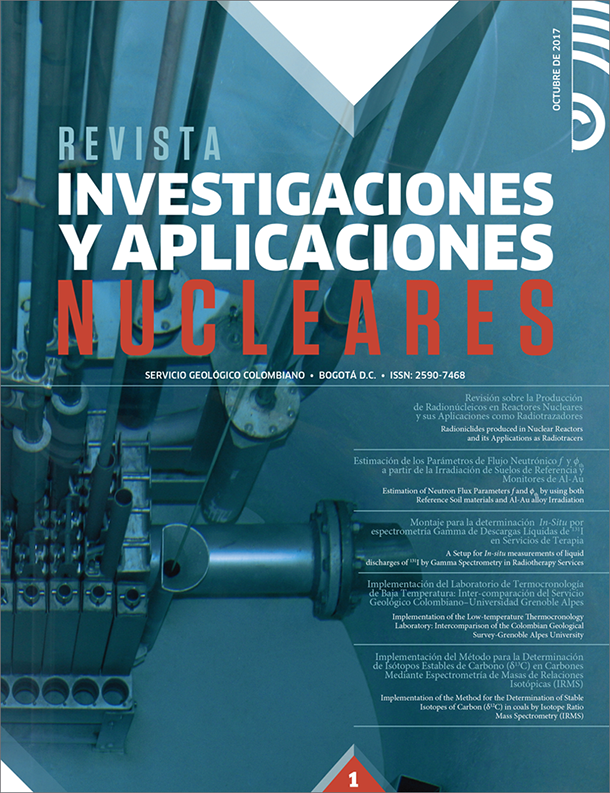Implementation of the low-temperature thermocronology laboratory: Intercomparison of the Colombian Geological Survey-Grenoble Alpes University
DOI:
https://doi.org/10.32685/2590-7468/invapnuclear.1.2017.20Keywords:
Apatites, Zircons, Colombia, Dating, Fission tracks, ThermochronologyDownloads
How to Cite
Issue
Section
Published
Abstract
This paper presents a historical description of the implementation process of the Low Temperature Thermochronology laboratory at the Colombian Geological Survey. The laboratory is focused on thermochronological dating of apatites and zircons with the fission track method. Here we explain the applied methodology, the results of the inter-calibration process performed in collaboration with the fission-track laboratory at ISTerre Joseph Fourier University and the internal inter-comparison of the SGC laboratory analysts. Furthermore, a viability study and irradiation conditions for fission track analysis in the nuclear reactor IAN-R1 is presented, in order to demonstrate the technical facilities, precision and reliability of the results obtained in the SGC laboratory to the scientific community.
References
-[1] M. I. Marín et al, Intercalibración de los laboratorios de Huellas de Fisión, Universidad EAFIT-JOSEPH FOURIER-INGEOMINAS, XIII Congreso Colombiano de Geología y XIV Congreso Latinoamericano de Geología, Medellín, Colombia. 2011.
-[2] X. Bustos et al., Comparación de Superficies de Erosión en el Altiplano Antioqueño mediante Geomorfología Cuantitativa: Resultados preliminares. XIII Congreso Colombiano de Geología y XIV Congreso Latinoamericano de Geología, Medellín, Colombia. 2011.
-[3] M. L. Peña, J. Sandoval y Y. Cañón, Laboratorios e Instalaciones de Tecnologías Nucleares y Reactor Nuclear del Servicio Geológico Colombiano, 14th Colombian Geological Congress, Bogotá, Colombia. 2013.
-[4] L. Rayo et al., Resultados irradiaciones para análisis de huellas de fisión, reactor nuclear IAN-R1 del Servicio Geológico Colombiano, 14th Colombian Geological Congress, Bogotá, Colombia. 2013.
-[5] A. Piraquive et al., Syntectonic erosion and exhumation processes in the Western Cordillera of Colombia, evidence from a tectonic stacking zone alongside the Romeral Suture Zone. 14th Colombian Geological Congress, Bogotá, Colombia. 2013.
-[6] C. Urueña et al., Termocronología aplicada al estudio de evolución térmica en cuencas carboníferas (Sinclinal Umbita). XV Congreso Colombiano de Geología, Bucaramanga, Colombia. 2015a.
-[7] C. Urueña et al., Termocronología aplicada en la Exploración de Gas Metano Asociado al Carbón. X Congreso Nacional y V Internacional de Ciencia y Tecnología del Carbón y Combustibles Alternativos – CONICCA 2015, Medellín, Colombia. 2015b.
-[8] S. Amaya, C. Zuluaga and M. Bernet. Tectonic Evolution of the Northern Andes, Colombia: New Age Constrains on the Exhumation of the Santander Massif. Lithos, in review.
-[9] S. Amaya, C. Zuluaga and M. Bernet. Three phases of accelerated exhumation along the Bucaramanga fault in the Cepita area of the south-western Santander Massif, Colombia, Tectonics, in review.
-[10] R. L Fleischer, P. B. Priceand and R. M. Walker, Nuclear Tracks in Solids. Principles and Applications. University of California Press, Berkeley, CA. 1975.
-[11] N. E. Holden, and D.C. Hofman, Spontaneous Fission Half-Lives for Ground-State Nuclides. Pure Appl. Chem, vol. 72, No. 8, pp. 1525-1562, © 2000 IUPAC. 2000.
-[12] R. Donelick, P. B. O’Sullivan, and R. Ketcham, Apatite Fission-Track Analysis: Reviews in Mineralogy & Geochemistry, v. 58, p. 49-94. 2005.
-[13] G. A. Wagner and P. van den Haute, Fission-Track Dating. Netherlands: Solid Earth Sciences Library, Kluwer. Academic Publishers. 1992.
-[14] K. Gallagher, R. Brown and C. Johnson, Fission track analysis and its applications to geological problems. Annual Review Earth Planetary Sciences, 26: 519-72. 1998
-[15] A.J Hurford, and P. F. Green, A user’s guide to fission track dating calibration. Earth Planetary Sciences Letters, 59: 343-354. 1982.
-[16] A.J. Hurford, “Standardization of fission track dating calibration: Recommendation by the Fission Track Working Group of Subcommision on Geochronology,” Chemical Geology (Isotope Geoscience Section), vol. 80: 171 -178. 1990.
-[17] P. W. Reiners and M. T. Brandon, “Using thermochronology to understand orogenic erosion,” Annu. Rev. Earth. Planet. Sci., 34, 419 – 466. 2006.
-[18] M. I. Marín et al., Calibración interlaboratorios de huellas de fisión. Universidad EAFIT - Servicio Geológico Colombiano - Universidad Joseph Fourier, 14th Colombian Geological Congress, Bogotá, Colombia. 2013.
-[19] A.K Ghosh, V. K. Sharma and R. K. Singh, Uplift History of Syenite Rocks of the Sushina Hill, Tamar Porapahar Shear Zone (TPSZ), Purulia: Constraints from Fission-track Ages of Two Cogenetic Minerals. Journal of Geology & Geophysics 5: 245, doi:10.4172/2381-8719.1000245. 2016.
-[20] M. L. Balestrieri, G. Bigazzi and M. Oddone, “The thermal column: a new irradiation position for fission-track dating in the University of Pavia Triga Mark II nuclear reactor,” J. Radioanal. Nucl. Chem, Letters 213 (2):99-108. 1996.







